Intro
With the Pope's blessing, the mayors of the palace usurped the throne from the last Merovingians, "the lazy kings". Pepin the Short, who became King of the Franks in 751, managed to restore the unity of the kingdom. With Queen Bertrade "Berthe au Grand Pied", the daughter of the Comte de Laon, a powerful lord of the time, Pépin had two sons:Charles and Carloman. Very quickly the eldest Charles imposed himself and announced his style, he called himself "the Great", and became one of the greatest sovereigns of France who marked the entire period of the High Middle Ages.
Great conquests
The struggle of the two brothers
On the death of the Frankish king in 768, the first difficulties appeared, the two brothers, Carloman and Charles did not get along, the division was therefore promising discord. According to Pépin's wishes:
- Charles obtained Austrasia and northern Neustria, he was crowned king at Noyon.
- Carloman obtained the South of Neustria, Burgundy and Provence, he sat in Soissons.
In 769, Aquitaine revolted, Charles asked for help from his brother, who refused him. Charles then pursues the Duke of Aquitaine and manages to restore order by threatening the Gascons (Basques) who finally deliver the rebellious Duke to him. But in 770, it is Lombardy which appears more threatening, the widow of Pépin, Bertrade organizes a marriage between Charles and Désirée the daughter of the king of the Lombards. But the two brothers still do not get along, and it is finally the death of Carloman in 771 that will change everything. Charles dismisses the inheritance of his nephews who flee with Gerberge, Carloman's wife, to the Lombard court (Gerberge is the daughter of the Lombard king). Charles is now sole King of the Franks.
Charlemagne

Detail of a mosaic from Strasbourg Cathedral
The conquest of Lombardy
Relations between Didier, the king of the Lombards and the young Frankish king deteriorated very quickly, Charles had repudiated Désirée who was very ugly. Pope Adrian I rejoiced at this opportunity, as his predecessor had done, he asked the Frankish king for help. Charles had a great interest in subjugating the Lombards, a constant threat, especially since their king Didier wanted to rehabilitate the sons of Carloman, refugees at his court, in the Frankish kingdom. Charles then crossed the Alps with his army, defeated the Lombards who took refuge in the city of Pavia, capital of the kingdom. In 774, the city fell and Charles took the title of "King of the Franks and the Lombards", he then made his triumphal entry into the capital wearing the famous iron crown, whose clasp, according to legend, was forged with a nail from the True Cross of Christ.
The Saxons, irreducible adversaries
Throughout his reign, the most consequent difficulties which Charles will have to face are related to the Saxons, a pagan people as irreducible in the face of the sword as of the call of the Gospel, who lived on the territories that have become today today Flanders and Lorraine in addition to their homeland of Saxony, now Germany. It took Charlemagne (from the Latin Carolus Magnus, Charles the Great) nearly a quarter of a century to completely subjugate them. The Saxons, who had promised concessions, took advantage of the Lombardy campaign to revolt again. But the Saxons are beaten again and finally promise their conversion to Christianity, Charlemagne returns with his share of Saxon hostages. Despite everything, the revolts continued none the less...
Charlemagne campaigning against the Moors

(National Library of Turin)
Against the Moors
For nearly a century, Christianity was threatened by the Moors who still occupied all of Spain. For the pope, like all Christians, it was up to Charlemagne to defend himself against this permanent danger. Charlemagne had no intention of conquering Spain, he was aware of the economic and cultural gap between the two worlds, moreover he admired the Islamic civilization, very advanced in trade, crafts, science and the arts. Still, Charlemagne invaded Catalonia and took the city of Pamplona. Then the bulk of the army fell back to join Germania, because the Saxons had rebelled again. The rearguard protecting the retreat then entered the Pyrenean valleys. It was commanded by Roland, Count of Brittany, a brave warrior much loved by Charlemagne. On August 15, 778, as she was in the narrow pass of the Roncevaux pass, the Gascons (Basques) descended from the top of the mountains and massacred the Frankish troops. “This cruel reverse, tells us a chronicler of the time, effaced almost entirely in the king's heart the joy of the successes he had had in Spain. This event became the best known feat of arms of the reign thanks to a great poem written towards the end of the 10th century, la Chanson de Roland . Charlemagne therefore contented himself with occupying strongholds in Catalonia.
The Song of Roland
This paragraph describes the story of the epic poem written at the end of the 11th century (beginning of the Crusades) where the Basques of Roncesvalles were replaced by Saracens. Ganelon, Roland's father-in-law, desirous of taking revenge on him as well as on the eleven peers who worship him, speaks with Marsile, a Saracen king, and gives him all the information that will allow him to exterminate the rearguard of Charlemagne. Roland was named head of this rearguard, with his eleven peers including Olivier, Count of Geneva and Roland's best friend. Charlemagne therefore has a gloomy presentiment. Marsile brought together 400,000 men, who rushed on the 20,000 Francs, landlocked in the Roncevaux pass. Out of pride, Roland then refuses to sound the olifant (horn) to recall Charlemagne. The first wave of Saracens (100,000 men) is countered and exterminated. But at the end of the fifth assault, the Franks are only 60. Roland then decides to sound the olifant, Charlemagne hears him but Ganelon dissuades him from taking it into account. The battle continues, Roland cuts the hand of Marsile who flees. Olivier, mortally wounded, dies in Roland's arms. Roland remains alone with his friend Turpin who are suddenly attacked by 400 Saracens who riddle them with arrows before fleeing. Dying Roland tries in vain to break his sword, the valiant Durandal, which breaks a rock. Roland then goes to bed with his face turned towards Spain and relies on God. Very affected Charlemagne condemns the traitor Ganelon, symbol of felony. Roland's fiancée, Aude, dies of grief. The poem makes a large part of the marvelous Christian and the love of the valiant knights for "sweet France".
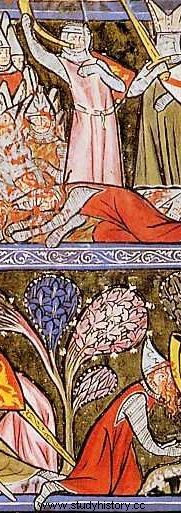
Roland blows the horn in Roncesvalles (medieval miniature)
Difficulties in Germania
The intractable Saxons rose up again, they ravaged the Frankish territory as far as the Moselle. Charlemagne therefore organizes a severe repression. But the revolts continued nonetheless. In 782, a Saxon leader, Widukind, succeeded in decimating a Saxon army that had rallied to the Franks and then took refuge in Danish territory. Charlemagne had every intention of annexing Saxony to his crown, but to do so he had to make the Saxons give in. Something that becomes less easy as the pagans applied Christian military tactics. In retaliation, Charles decided to carry out a terrible massacre, near Verdun, 4,500 Saxons were executed, women and children were not spared.
Conquests in Central Europe
- The uprising of the Saxons also encouraged the Duke of Bavaria, Tassilo III, who in 779 refused to recognize Frankish sovereignty and was on the point of causing trouble throughout the southern part of Germania occupied by the Franks. But abandoned by his subjects, Tassilon was finally beaten and imprisoned. Bavaria was thus integrated into the kingdom in 788. Charlemagne confiscated the immense possessions of Tassilon, who was considered "the richest man in the Empire", more than Charlemagne himself who, moreover, never had of personal fortune and was one of the first kings of medieval times to distinguish between the Royal Treasury and his own possessions.
- Then, after Bavaria, Charles faced the Avars, a warlike tribe of Mongol origin, like the Huns, who were established in Pannonia (present-day Hungary). The war against the Avars was merciless. Charlemagne responded to the ferocity of the enemy with an equal ferocity. The confrontation ended with the taking of the Avar royal camp by Pepin, the son of Charlemagne. Their lands were placed under the control of the Franks, then Christianized. A similar treatment was reserved for the Bohemian Slavs. Following these conquests, the territories of Germany, Hungary, Bohemia and part of Yugoslavia were wrested from the barbarian grip.
Emperor
The coronation of Charlemagne
Relations between Charlemagne and Pope Adrian I were not so exemplary, Tuscany and all of southern Italy was promised to the pope, but the Frankish ruler preferred to impose his own rule over Italy. The independence of the States from the Pope was increasingly fictitious. Despite everything, Charles is concerned about his political construction, and he knows that the religious factor is essential. Also, when the new pope Leo III was imprisoned in 799 and beaten up by nobles who accused him of immorality, Charlemagne intervened and ensured the pope's return to Rome under good escort. In gratitude for service rendered, notably against the Lombards, Charlemagne took the new title of “Emperor of the Romans”. The ceremony takes place at St. Peter's Basilica in Rome on December 25, 800. He presents himself symbolically as a distant continuation of the Western Roman Empire. This is how he wears the one-headed eagle as his emblem.
The coronation of Charlemagne
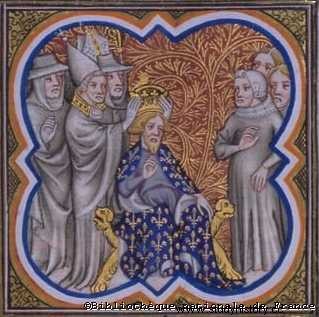
(National Library of France)
The conquest of Germania
The most arduous task for Charlemagne was to submit the Saxons definitively in order to attach Germania to the Empire, and to pacify it. In 785, the barbarian chief, Widukind, fell ill, he was then obliged to yield his command. From then on, the Saxon campaigns were no longer as harsh or as laborious for the Franks, who ended up winning in 799. But guerrilla warfare, repressions and mass deportations resumed and were not completed until 804. that year, Charlemagne had recourse to great means, by deciding that "any Saxon not baptized and who refuses to be baptized would be punished with the death penalty". In addition, he deported the entire Saxon population residing between the two rivers of the Elbe and the Weser. As it was pacified, Germania was divided into marches (defense zones) led by Frankish leaders.
The organization of the Empire
The Carolingian Empire
At the beginning of the 9th century, the Frankish state already represented a vast Empire and its borders were strongly consolidated. After the coronation of Charlemagne, the center of gravity of the Empire shifted towards the East, that is to say to the detriment of France and to the benefit of Germany. The capital was established in Aachen, a Germanic city known as "Aix-la-Chapelle". Charlemagne appreciated the thermal waters of this city, which allowed him to cure his gout and his rheumatism. The announcement of the coronation could not please Constantinople, which saw in Charlemagne a usurper. The Byzantine Empire, in front of the displayed demonstration of power, moved towards transactions between the two empires, and these were put in place. For a moment, it was thought to marry the Emperor of the West, to Irene, the Sovereign Empress of the East, the plan could not succeed. At this time, there are three rival empires:the Carolingian Empire, the Byzantine Empire and the Arab Empire. This new world, because of religious antagonism could not take advantage of maritime relations between East and West, unlike the Roman world. Hence the restructuring of the Frankish Empire which turned towards an economic activity located between the Rhine and the Meuse, favoring the future Germany.
The Empire of Charlemagne

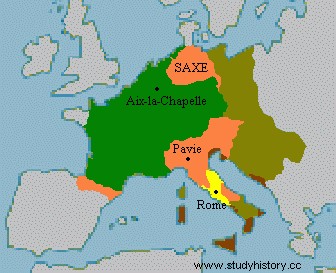
Man of war, man of peace
The portrait of Charlemagne is known to us thanks to Einhard, a contemporary historian. Tall (he was 1.92 m tall), strong and vigorous, Charlemagne inspired the respect of his enemies who, on the battlefield, feared his physical strength more than his tactical intelligence. Of real kindness, he liked to give alms to the poor, could burst into tears at the news of the death of a friend, and venerated his mother Bertrade, whom he often consulted. Very attached to his family, he never separated from his children, and was married four times. Charlemagne has a great curiosity of spirit, he learns a lot to compensate for his shortcomings, he thus gives a complete education to his children. But he was first and foremost a warrior, though his stated goal was peace. Deeply religious, convinced that God had entrusted to the Frankish people and their sovereign the task of spreading and defending the Christian faith as well as the customs it brought with it, he spent his life fighting the Barbarians, from north to south of Europe. By iron and blood, he succeeded in establishing a Christian empire over most of Western Europe, so much so that historians later attributed to him the title of Pater europae , father of modern Europe.
The Missi Dominici
The emperor could not always control how his orders were carried out. Charlemagne therefore entrusted safe offices to people who were “the eyes, the ears and the tongue of the sovereign”. They were the missi dominici (sent from the master). True inspectors general of the kingdom, they had full powers to call counts and marquis to order, to monitor the functioning of justice and the state of finances. The missi dominici were generally two in number:a religious and a layman. Their mission was to carry out investigations, to control the administration of the provinces and to report to the emperor the abuses they had been able to observe.
The missi dominici presenting themselves before Charlemagne

Counts and marquises
Following the practice of the Franks, Charlemagne divided the empire into counties (there are more than 200 in the Empire); at the borders, he created marches or buffer regions intended to protect against external invasions. Counties and markets, living in relative autonomy, were entrusted to the most faithful of his companions (counts and marquis). The emperor visited them periodically; he then received the representatives of the population and the heads of the clergy, controlled the accounts, decided on the works to be undertaken. In each county there were regularly held provincial assemblies or pleas (from the Latin platicium, convention), which served as courts of justice. The judges or aldermen, regulated ordinary affairs. But the most important judgments were pronounced by the count or by the royal court.
General Plaids and Champ de Mai
The counts and marquis behaved on their territory like true petty sovereigns. In reality, they were vassals of the emperor, who owned the land. In order to centralize his power, Charlemagne held general pleas (on average three times a year). All those who counted in the Empire were invited:marquises, counts, bishops, abbots (monastery superiors)... In these meetings, all the problems of the Empire were discussed, and laws were established. Empire officials then transcribed them in an orderly fashion by dividing the text into chapters. Bearing the signature and seal of Charlemagne, these chapters, or capitularies were spread in the provinces to be applied there. Charlemagne thus tried to replace the traditional oral decisions by writings. The Champ de Mai (applied to the month of May) is a general plea that regulates military matters.
“The Emperor with the Flowery Beard”
By lending the emperor a beard when he was probably beardless, the representations of the sovereign want to emphasize his virile authority. As for the qualifier of fleurie, it is a bad translation of "flori", which means white in old French.
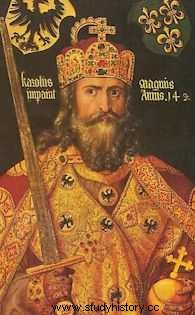
Carolingian society
A warmongering society
In the Carolingian Empire, war was of paramount importance:it was considered a normal activity, almost a necessity. During the reign of Charlemagne, the years when there was no military campaign can even be counted on the fingers of one hand. The fighting period was between May and October. The goals pursued were diverse:to put a recalcitrant or traitor count in his place, to amass booty by raids beyond the borders and, of course, to conquer territories and Christianize the infidels. From all regions of the Empire arrived whole armies with arms and baggage, led by a count or marquis. The emperor himself reviewed the Frankish army. The Champ de Mai was thus not only an assembly of leaders, where future military operations were decided, but also an opportunity to reaffirm with brilliance the unity of the Empire around the sovereign and his army.
Carolingian society
- The serfs, economic engine :The economy at the time of the Carolingians was based on the work of the serfs. These were not strictly speaking slaves, but people subject to a master, who had to accomplish the task that they were ordered to and who remained attached to a domain. The villas were the object of particular attention:an agricultural domain living in autarky, that is to say producing everything that is necessary for the life of its inhabitants, the villa formed the basic economic unit of the Empire.
- The clergy, cement of the peoples :Charlemagne relied throughout his reign on the Church. Christianity formed the cement uniting the peoples of the Empire, who had neither language nor customs in common. Although he always kept a very close watch on religious affairs, the emperor gave a prominent place to the dignitaries of the Church.
Charlemagne and the bishops

(National Library of France)
The Carolingian Renaissance
- The creation of schools :In order to train competent administrators, Charlemagne favored a revival of studies, he created among other things the School of the palace, which Alcuin will direct. After numerous councils, Charlemagne succeeded in imposing religious reforms (liturgical reform, discipline in the abbeys, writing). Charlemagne was indignant at the coarse style of certain ecclesiastics, so the clergy had to be educated, hence the establishment of schools near churches and monasteries. The Church thus moved on to the effort of educating the people. In the monasteries, the Holy Scriptures are copied in an elegant way (new rounder script:Caroline script) and in correct Latin.
- Charlemagne, restorer of arts and letters :Under the influence of Byzantine art, the churches will be decorated with mosaics and frescoes. The bindings of the Bibles are decorated with bas-reliefs, miniatures or delicate illuminations are also painted. Relics and manuscripts are thus decorated by great goldsmiths. The arts and letters underwent a brilliant renaissance, the Latin language was restored, brilliant people like Alcuin or Angilbert revived the taste for ancient culture. The architecture also underwent a veritable artistic renaissance, inspired by Roman art. Religious constructions are experiencing a real boom, the Palace of Aix also bears witness to the renewal of civil architecture.
Charlemagne's monogram
Einhard taught Charlemagne to sign this way:a cross comprising the letters of Karolus , the consonants are at the ends, the vowels located in the central diamond.
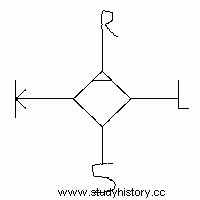
The death of the sovereign
The death of the sovereign
After the submission of the Saxons in 804, Charlemagne undertook his last military campaigns:against the Arabs of Spain, the Avars or the Bretons, but also the Slavs, the Saracens, the Greeks and the Danes. In 812, the Eastern Roman Emperor Michael I recognized Charlemagne as Western Roman Emperor. Charles then thinks about his estate:
- Of all his sons, one Pepin the Hunchback had tried to overthrow him, he was locked up in a monastery.
- Charles the Younger, who had received the anointing from the pope at the time of his coronation, was destined to succeed but died in 811.
- The second son of Charlemagne, Pepin was king of Italy, he distinguished himself by capturing the treasure of the Avars, "the Ring", he died in 810.
- It was then Louis (the Pious or the Debonair) who succeeded Charlemagne, he was crowned in 813, during his father's lifetime.
Charles was strong and robust, he was sick only during the last four years of his life, he began to limp and suffer from fever. In 814, he died of pleurisy, he was buried in the basilica of Aix-la-Chapelle. The unity of the Empire, which was already difficult to maintain because of the immensity of a territory extending from the Baltic to the Adriatic and because of the system of counties and marches, a source of fragmentation, could be safeguarded as long as Charlemagne was alive, but was hardly to survive the disappearance of the "cement" represented by his authority and his prestige.
